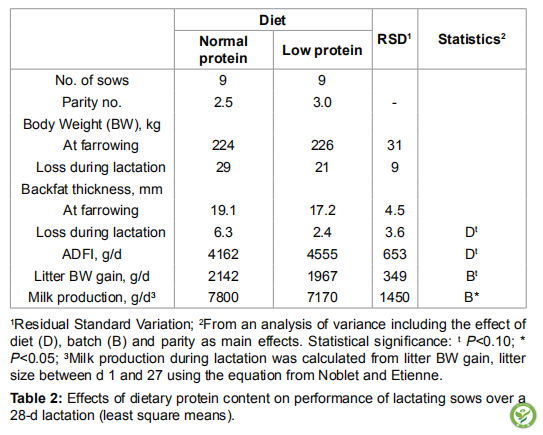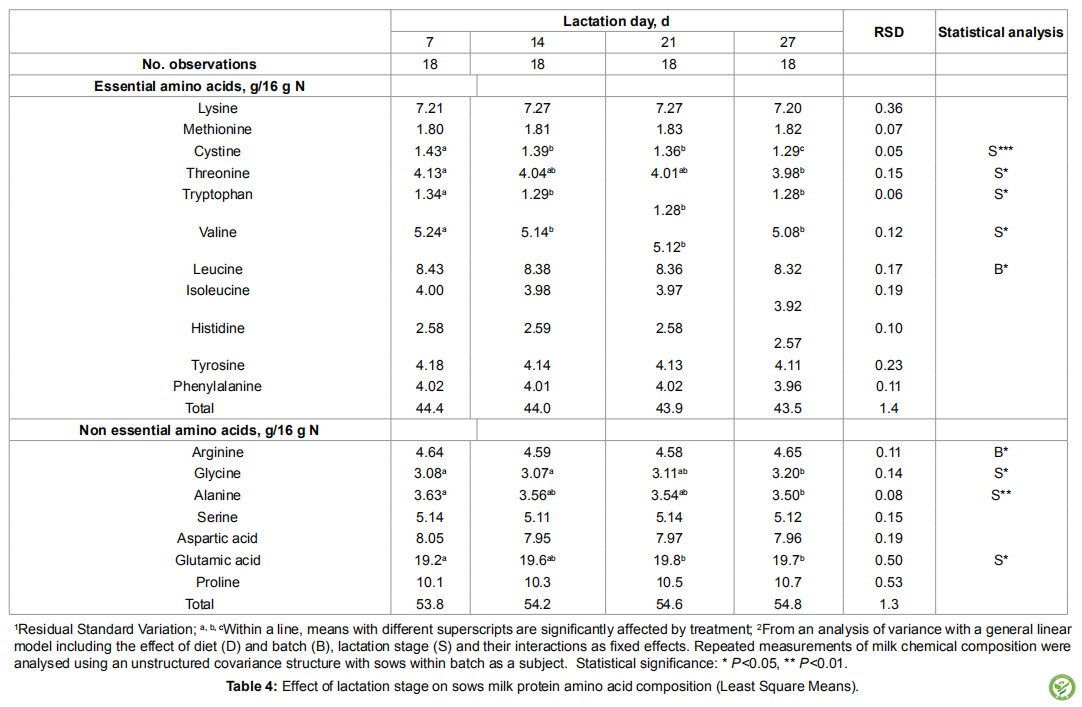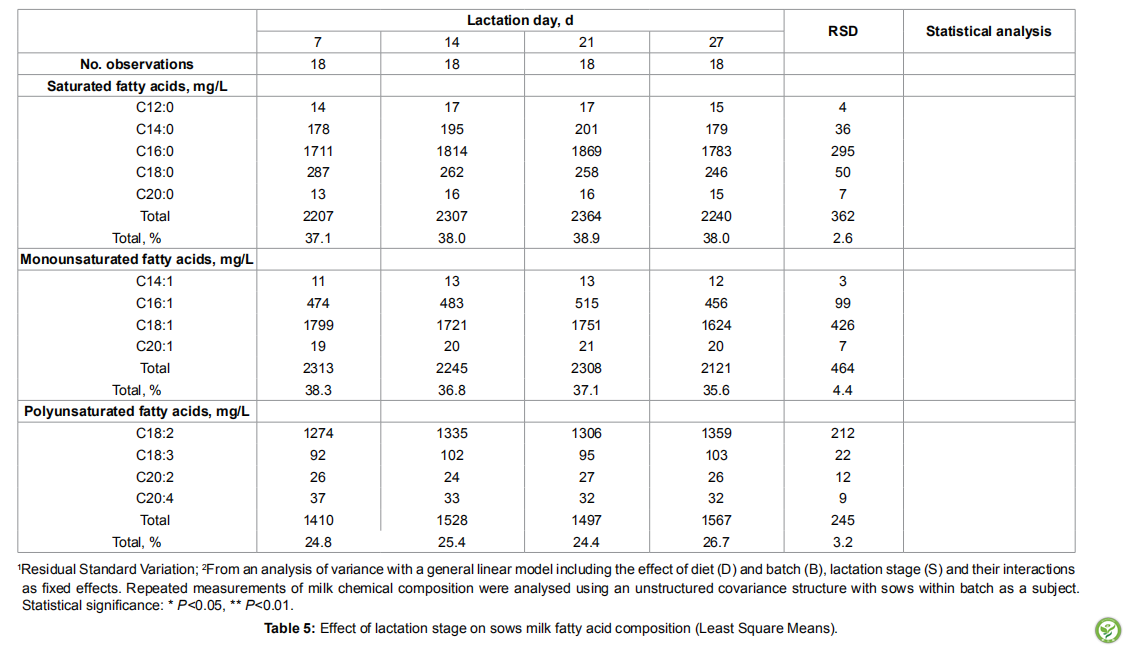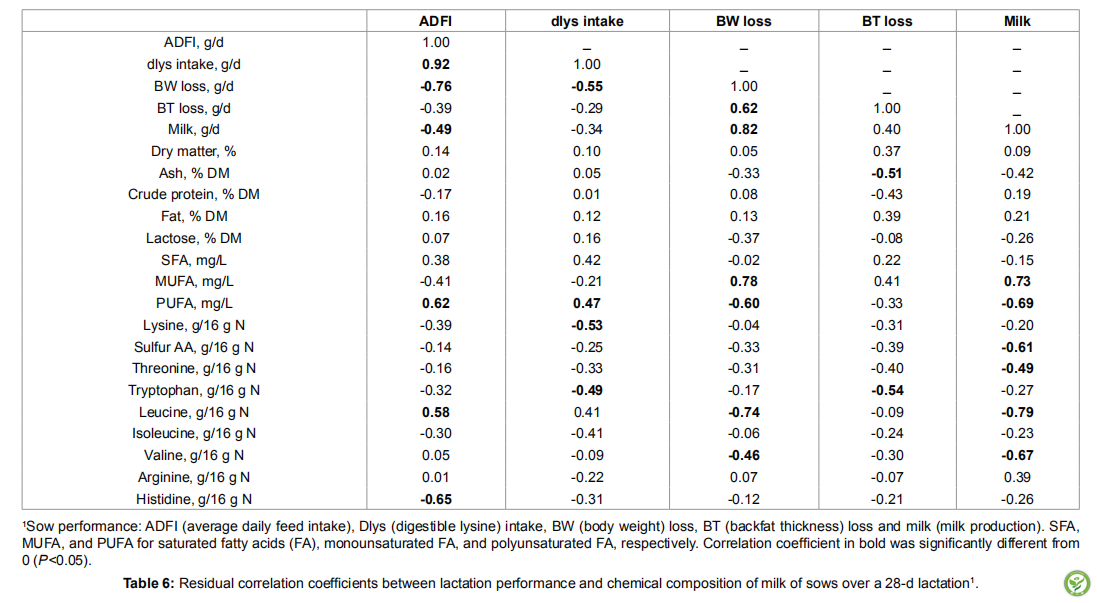原标题:日粮中蛋白质含量对热带潮湿气候下的杂交型哺乳母猪奶水组成成分的影响
Effects of Dietary Protein Content on Milk Composition of Mixed Parity Lactating Sows in a Tropical Humid Climate
作者:Silva BAN1,2*, Gourdine JL2, Corrent E3, Primot Y3, Mourot J4, Noblet J4 and Renaudeau D2,4
1Institute of Agricultural Sciences/ICA, Federal University of Minas Gerais (UFMG), 39404-547, Montes Claros, Minas Gerais, Brazil
2INRA UR 143 Zootechnical Research Unit, F-97170 Petit Bourg, Guadeloupe, France
3Ajinomoto Eurolysine S.A.S. 153, Rue de Courcelles, F-75817 Paris Cedex 17, France
4INRA, UMR Breeding Systems, Animal and Human Nutrition INRA UMR 1079, 35590 St Gilles, France
来源:Silva et al., J Vet Sci Technol 2017, 8:4
DOI: 10.4262/2157-7579.1000448
翻译:肠动力研究院 梁琦
【摘要】在潮湿的热带气候条件下,18头多胎大白母猪被用来评估日粮中蛋白质含量和哺乳期长短对以28天为哺乳期的母猪奶水组成成分的影响。该项研究在法国西印度群岛瓜德罗普岛(北纬16°,东经61°W)的INRA设施中心进行。试验期间的平均最低和最高环境温度和平均日相对湿度分别为22.7和29.4°C,以及93.7%。实验分组如下,正常蛋白质组(NP):日粮中添加17.3%的粗蛋白;低蛋白质组(LP):日粮中除含有14.1%的粗蛋白外还额外添加了必需氨基酸。实验结果显示,与NP处理相比,饲喂LP日粮的母猪平均日采食量(ADFI)趋于更高(即+9%,P<0.10)。断奶仔猪的窝日增重和平均体重几乎不受实验组中蛋白质水平差异的影响(P>0.10)。同样,实验各组的哺乳期母猪的体况损失没有显著性差异(P>0.10)。饲喂LP日粮的母猪比饲喂NP日粮的母猪,背膘厚度损失更少(分别为2.4和6.3mm; P <0.10)。泌乳量和奶水成分不受处理组的影响(P>0.10)。奶水中干物质和灰分含量随泌乳期线性增加(第7-27天干物质从17.6%增加到19.9%,灰分从0.72%增加到0.97%; P <0.01);乳糖含量从第7天增加到第14天(3.95 vs 4.91; P <0.01),此后保持不变;哺乳期间奶水中脂质含量没有显著变化,平均为7.5%。构成乳蛋白的氨基酸浓度受哺乳期长短的影响:从第7天-27天,蛋氨酸,苏氨酸,色氨酸,缬氨酸和丙氨酸的浓度随哺乳期的延长而显著降低(P <0.05),但甘氨酸和谷氨酸的含量显著增加(P <0.05)。奶水中脂肪酸的组成不受哺乳期长短的影响(P>0.01)。哺乳期母猪的体况损失与平均日采食量呈负相关(r = -0.76; P <0.05),与背膘厚度减少呈正相关(r = 0.55; P <0.05)。此外,研究人员还观察到:母猪的泌乳量的高低与其动员机体储备呈正相关(r = 0.82; P <0.05)。乳脂中多不饱和脂肪酸含量与ADFI呈正相关,而与母体体况损失呈负相关(r = 0.62,r = -0.60; P <0.05)。实验结果表明:降低日粮中蛋白质含量的同时,增加ADFI可以减轻母猪受到热应激的负面影响。奶水成分随着哺乳期延长而发生显著变化,母猪泌乳能力的高低很大程度上取决于它们动员自身机体储备以提供奶水合成的前体物质的能力。
【关键词】母猪;哺乳期;乳汁;氨基酸;脂肪酸
表1:哺乳日粮的组成,作为饲喂基础及分析哺乳日粮的化学组成成分

表2:日粮中蛋白质的含量对泌乳期超过28天的哺乳母猪生产性能的影响

表3:哺乳期长短对母猪奶水的化学物质组成成分的影响

表4:哺乳期长短对母猪奶水中乳蛋白中的氨基酸组成的影响

表5:哺乳期长短对奶水中脂肪酸组成的影响

表6:泌乳日期超过28天的哺乳母猪的奶水的化学组成成分与泌乳期生产性能的剩余相关性
 Eighteen multiparous Large White sows were used to determine the effects of dietary protein content and lactation stage on milk composition during a 28-d lactation under humid tropical climatic conditions. This study was conducted at the INRA facilities in Guadeloupe, French West Indies (latitude 16°N, longitude 61°W). The average minimum and maximum ambient temperatures and average daily relative humidity during the trial were 22.7 and 29.4°C, and 93.7%, respectively. The dietary experimental treatments were a normal protein (NP, 17.3%) diet and a low protein (LP, 14.1%) diet supplemented with essential amino acids. The ADFI tended to be higher for the sows fed the LP diets when compared with the NP treatment (i.e., +9%, P<0.10). Litter BW gain and mean BW of piglets at weaning were not affected by dietary protein level (P>0.10). The treatments did not in uence (P>0.10) sow body weight loss during lactation. The sows fed LP diets tended to show lower backfat thickness losses when compared to the sows fed NP diets (2.4 vs. 6.3 mm, respectively; P<0.10). Milk production and composition were not affected by dietary treatments (P>0.10). Milk dry matter and ash contents linearly increased according to lactation stage (17.6 to 19.9%, and 0.72 vs. 97%, respectively from d 7 to d 27; P<0.01). Lactose content increased from d 7 to d 14 (3.95 vs. 4.91; P<0.01) and thereafter remained constant. Fat content did not change during lactation and averaged 7.5%. The amino acid concentrations in milk protein were affected by the lactation stage: methionine, threonine, tryptophan, valine, and alanine concentrations decreased (P<0.05) but glycine and glutamic acid contents increased (P<0.05) from d 7 to d 27. Fatty acids milk pro le was not in uenced (P>0.10) by lactation stage. Maternal BW loss during lactation was negatively correlated with the average daily feed intake (r=-0.76; P<0.05) and positively correlated with backfat thickness loss (r=0.55; P<0.05). A positive correlation between milk production and body reserves mobilisation (r=0.82; P<0.05) was also observed. Polyunsaturated fatty acid content in milk fat was positively correlated with ADFI and negatively correlated to maternal BW loss (r=0.62 and r=-0.60; P<0.05). In conclusion, reducing dietary protein content can be an alternative to attenuate the negative effects of heat stress by increasing ADFI. Milk composition changes signi cantly according to lactation stage and the ability of sows to produce milk will depend on their capacity to mobilize body reserve for providing milk precursors.
Eighteen multiparous Large White sows were used to determine the effects of dietary protein content and lactation stage on milk composition during a 28-d lactation under humid tropical climatic conditions. This study was conducted at the INRA facilities in Guadeloupe, French West Indies (latitude 16°N, longitude 61°W). The average minimum and maximum ambient temperatures and average daily relative humidity during the trial were 22.7 and 29.4°C, and 93.7%, respectively. The dietary experimental treatments were a normal protein (NP, 17.3%) diet and a low protein (LP, 14.1%) diet supplemented with essential amino acids. The ADFI tended to be higher for the sows fed the LP diets when compared with the NP treatment (i.e., +9%, P<0.10). Litter BW gain and mean BW of piglets at weaning were not affected by dietary protein level (P>0.10). The treatments did not in uence (P>0.10) sow body weight loss during lactation. The sows fed LP diets tended to show lower backfat thickness losses when compared to the sows fed NP diets (2.4 vs. 6.3 mm, respectively; P<0.10). Milk production and composition were not affected by dietary treatments (P>0.10). Milk dry matter and ash contents linearly increased according to lactation stage (17.6 to 19.9%, and 0.72 vs. 97%, respectively from d 7 to d 27; P<0.01). Lactose content increased from d 7 to d 14 (3.95 vs. 4.91; P<0.01) and thereafter remained constant. Fat content did not change during lactation and averaged 7.5%. The amino acid concentrations in milk protein were affected by the lactation stage: methionine, threonine, tryptophan, valine, and alanine concentrations decreased (P<0.05) but glycine and glutamic acid contents increased (P<0.05) from d 7 to d 27. Fatty acids milk pro le was not in uenced (P>0.10) by lactation stage. Maternal BW loss during lactation was negatively correlated with the average daily feed intake (r=-0.76; P<0.05) and positively correlated with backfat thickness loss (r=0.55; P<0.05). A positive correlation between milk production and body reserves mobilisation (r=0.82; P<0.05) was also observed. Polyunsaturated fatty acid content in milk fat was positively correlated with ADFI and negatively correlated to maternal BW loss (r=0.62 and r=-0.60; P<0.05). In conclusion, reducing dietary protein content can be an alternative to attenuate the negative effects of heat stress by increasing ADFI. Milk composition changes signi cantly according to lactation stage and the ability of sows to produce milk will depend on their capacity to mobilize body reserve for providing milk precursors.
Keywords: Sow; Lactation; Milk; Amino acids; Fatty acids
如您需原文,请联系本文作者和出版方,或请垂询肠动力研究院。本网站发布的所有资料将尽最大可能注明出处、作者及日期,如无意中侵犯了您的知识产权,请来信及时告知,我们将立即予以删除。
All information released by the WeChat Official Account will do its best to indicate the source, author and date. If we inadvertently infringe on your intellectual property, please inform us in time and we will delete it immediately.





